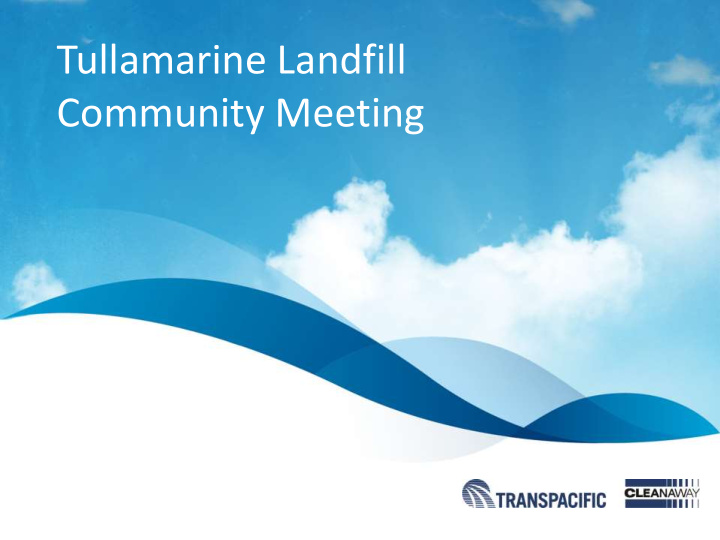



Tullamarine Landfill Community Meeting
Rehabilitation Update 25 th November 2015 Presented by Kieren McDermott Environmental Specialist - Transpacific Cleanaway
Discussion Topics Rehabilitation Road Map Flare stack sampling update Community Influence on Landfill Management Risk Assessment (to be run by EPA)
Flare Sample Update Flare service planned for December 2015 Next round of sampling planned before February 2016 Sampling to be completed at the same time as Ambient Air Sampling
Flare Performance Update To perform optimally flare must operate at Above 760 degrees C in the flare chamber, and Flow rate of between 40 m3/hr and 200 m3/hr.
Measured Flare Performance Flare operation data to date >950 degrees as measured in stack and >850 degrees at exit point Measured flow rate is approximately 160 m3/hr
Flare measurements Date Time Methane_Percent Stack_Temp_C Instan_Flow_M3_h 14/02/2015 0:00:00 62.0625 898.344 159 14/02/2015 0:15:00 62.0625 899.406 158 14/02/2015 0:30:00 61.9063 895.688 159 14/02/2015 0:45:00 62.125 899.406 161 14/02/2015 1:00:00 62.125 897.281 161 14/02/2015 1:15:00 62.1563 898.875 161 14/02/2015 1:30:00 61.8438 895.156 157 14/02/2015 1:45:00 62.4063 897.813 160 14/02/2015 2:00:00 62.8438 897.281 160 14/02/2015 2:15:00 62.4063 897.813 162 14/02/2015 2:30:00 62.6875 897.813 160 14/02/2015 2:45:00 62.6875 896.75 161 14/02/2015 3:00:00 63.0625 898.344 161 14/02/2015 3:15:00 63.0938 899.938 159 14/02/2015 3:30:00 63.1563 901 159 14/02/2015 3:45:00 63.125 899.406 157 14/02/2015 4:00:00 63.0625 897.813 160 14/02/2015 4:15:00 63.125 898.344 161 14/02/2015 4:30:00 63.0938 898.344 159 14/02/2015 4:45:00 63.0625 897.281 162 14/02/2015 5:00:00 62.875 897.281 157
Flare Performance So Far Based on the temperature the flare has achieved this efficiency and is performing better than design. TCL has engaged engineers to accurately calculate efficiency.
Sample Plan Flare Ambient Air Sample Point
Ambient Air Test Parameters Poly Aromatic Hydrocarbons (PAHs) Dioxins / Furans Metals Volatile Organic Compounds (eg. Methane, Benzene) PM10 and PM2.5
Areas Community Influenced Landfill Best Practice Surface water Direction / Steering monitoring The cap LNAPL Trial Landfill gas Much improved management outcomes Groundwater monitoring
Example - Best Practice Cap The best available technology was employed as determined by the cap designer (Golder Associates) Construction quality control was delivered to the highest standards as verified by the cap auditor and Thiel Engineering Cap infiltrates around 2 mm to 3 mm per century as estimated by Thiel Engineering (at least 10x less than standard cap)
Example - Landfill Gas Management Best available technology was employed as assessed by URS Engineers (Enclosed flare) Stack test platform and sample ports installed (not required) Stack testing program (not required) Ambient air testing program (not required) Input to LFG Audit (last meeting)
Example - Groundwater Sampled an extra 30 boreholes this year over and above management plan requirements Input to Technical Review for Auditor Review (TRAR) and Groundwater Monitoring Plan for next three years Reviewed PCB and Formaldehyde data Contingency protocol reviewed
Example - Creek Water Quality Frog and macro invertebrate surveys Quarterly monitoring frequency Water quality and habitat appears to be improving
Example - LNAPL Trial Design Pre trial design changes: No storage on site No reinjection Disposal by incineration (first time in Victoria) Extra gas release prevention measures (extra carbon filters, and vacuum on wells while pumping).
Example - LNAPL Trial Assessment Review of landfill contingency protocols At least two extra consultation events. Practicability Assessment Report (2 nd Report)
Community Influence has Improved Landfill Management Outcomes Much better dialogue between business, regulators, experts and community. Improved focus on community needs. Much better outcomes for all including the environment.
Thank you
Recommend
More recommend